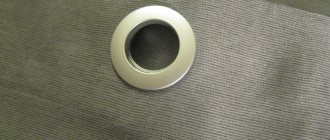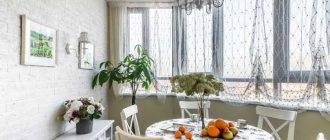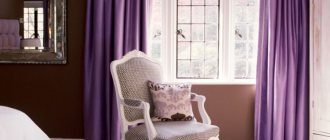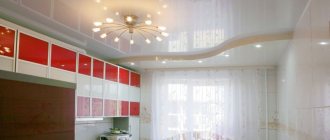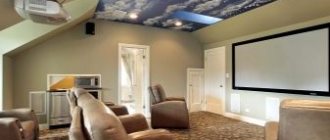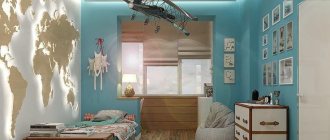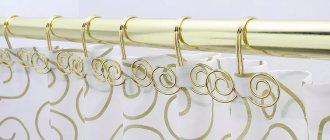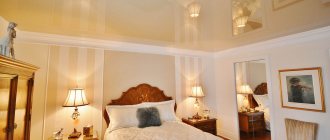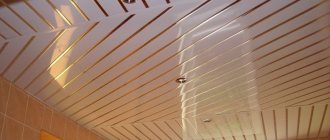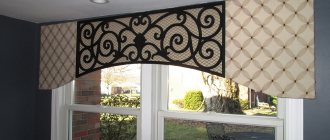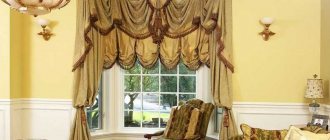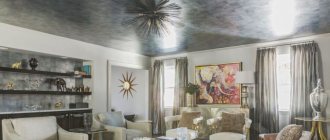The modern variety of design options for curtain rods and types of curtains for them allows you to choose the best, most suitable one. A solution such as ceiling curtain rods for suspended ceilings has an aesthetic appearance, allowing you to partially or completely hide unwanted details. They are easy to hang almost any curtains, including heavy two- or three-layer ones, as well as roller ones made of various materials.
It is important to select a suitable cornice even before you install the tension structure.
Stretch ceilings, cornices: how compatible are these interior design elements?
In various options, curtains come directly from the ceiling or are fixed high on the wall, but the combination of hanging, tensioning systems with a cornice has some technical limitations.
Ceiling cornice is a bright individualization of the ceiling area and the room as a whole.
The high popularity of the ceiling structure is due to the following factors:
- This design for the top of the room is relatively simple, you can do it yourself;
- the design comes out beautiful and does not lose its appearance for a long time;
- the tension object is reliable, as it protects against excess noise and possible flooding from neighbors above;
- The variety of textures and colors allows you to match it to almost any interior style.
It provides a visual expansion of space.
Advice. The first thing you should decide on is the installation location, the type of curtain rod itself, and the appropriate type of curtains.
Compatibility of cornices with suspended ceiling systems
Now stretch ceilings are deservedly considered one of the most successful techniques when creating a ceiling design, and the reasons for this popularity are as follows:
- Work on arranging such a structure is less labor intensive compared to other methods of designing the floor. Possession of certain skills allows you to install the tension fabric yourself.
- Such ceiling systems are distinguished by high aesthetic values. They have a rich color palette, the texture of their surface can be varied, as well as the forms of implementation.
From all of the above, we can conclude that installing a suspended ceiling can be simple and quick. This type of design best transforms the interior of the room. You just need to understand how to attach the cornices on which the curtains are to be hung to the ceiling with suspended ceilings, and which of them can be used.
There is a varied selection of crossbars on sale that can be used in combination with different types of ceiling structures. The main thing that needs to be done in advance is to decide on the location of the cornice behind the ceiling and the type of curtains.
Types of cornices used simultaneously with tension systems
Curtain rods for tensioning structures can be ceiling, wall, or hidden. They look and are mounted in different ways. As a constructive type of home decor, a simple cornice serves for hanging curtains, representing a profile or a thin pipe along which fasteners in the form of rings, hooks, etc., move with a slight movement from side to side.
Wall-mounted models are mounted on two brackets.
The curtain, suspended on fastenings, performs an aesthetic, light-protective, masking, and, less often, zoning, fire-fighting function. For thin decorative curtains, a lightweight hanging structure is purchased; for multi-layer, dense, heavy ones, it is securely fastened, as it experiences increased load.
Steel curtain rods are great for heavy curtains.
Wall hangings are the most common in all types of interiors. They can be profiled - one, two or three rows or in the form of a rod, two to four meters long. The product can be installed anywhere on the wall – even almost in close proximity to the “sky” of the room.
There are combined models.
The ceiling element, always mounted together with a suspended ceiling, looks different. When choosing, take into account:
- appearance of the product;
- its cost;
- correct choice of shape and design;
- installation complexity;
- ease of use.
This will visually raise the ceiling.
Installing a cornice directly on the ceiling visually increases the height of the room, but installation on a tensioned surface will require additional reinforcement of the latter.
If you want the curtains to flow straight from the ceiling, then you need to make a niche in front of the wall.
A hidden cornice is the most beautiful, stylish option, in which the curtains and ceiling form a single ensemble. It is quite difficult to install a product correctly and accurately - if you do not have experience, it is better to entrust this work to a specialist, then the excellent result will compensate for all the costs.
Single-tier models place all curtain panels on the same level.
How to attach a cornice to a suspended ceiling
How, in practice, with your own hands, attach a cornice to a suspended ceiling? Everything is simple here: you need to find the place where the timber is attached and screw the cornice directly to it with self-tapping screws.
It is very important here that there is not a millimeter of gap between the beam and the ceiling film, since if there is one, then you will pull the canvas in the other direction with bolts and the entire ceiling will “lead.”
So, if you felt and realized that the beam is far enough away, then it is better not to take risks and not make extra holes, but to go and buy another type of cornice. This is much cheaper than replacing a damaged ceiling later.
And one more thing: when choosing a timber, pay attention to its flatness, using a water level for this. If it differs in height at least in one place, then this will certainly be reflected on the ceiling, and you may simply not notice the difference visually.
Attaching cornices to suspended ceilings: how to do it step by step
Since the ceiling and wall hanging elements are two different structures, they will be attached differently. The fixture for the walls can be hung at any time, while the installation location for the ceiling is planned in advance - it will be impossible to move it.
A visual effect of a textile waterfall is created.
How to attach a ceiling cornice
The stretched material itself is soft, thin, elastic. To prevent the product from deforming under the weight of the curtains and cornice, I reinforce it with wooden blocks mounted between the base plane and the curtain itself. When using heavy, multi-row curtains, several curtains should be taken - this is necessary to strengthen the entire structure.
The main difficulty here is that the place where the cornice will be suspended is determined by the master in advance - even before the ceiling is stretched.
What else is important to consider:
- Before installing the rough ceiling, you need to mark it and make a sketch;
- the block is chosen a little thinner than the distance from the concrete to the film - the embedded parts should not rest against the stretched fabric;
- the wood of the bars is pre-treated with special compounds that prevent rotting and mold;
- to install the cornice on the ceiling surface, you need reinforced rings - they are fixed where the suspension connects to the mortgage. A place for fastenings is cut out inside the ring;
- When hanging the product, folds, wrinkles, and unevenness should not form on the stretch fabric.
Models are available in plastic or aluminum. Their distinctive feature is the presence of a decorative strip covering the hooks.
How to attach a wall cornice
A wall-mounted curtain rod allows you to hang curtains almost to the very top, but not closely - for free moving structural elements (rings, eyelets) you must leave a distance of at least 1.5-6.5 cm, otherwise these parts will quickly scratch or rub through the film or fabric ceiling.
It is also important to choose curtains that match the color of the top of the room, the hanging itself.
Ceiling cornice installation technology
You can install the ceiling cornice yourself without the help of specialists, if you follow certain rules during the work process.
Features of installing fastenings under the cornice
At this stage it is important to take correct measurements. The slightest deviations will lead to the structure being installed at an angle, which will spoil the overall appearance of the decor. To securely fix the mount, follow these tips:
- perform the fastening on the base surface of the ceiling (concrete), this will ensure greater reliability;
- To decorate the cut in a baguette, purchase special overlays. You will find them in construction stores;
- You can increase rigidity by gluing profile strips to each other;
On a note! To ensure that the ceiling cornice in a suspended ceiling is not visible from the far corners of the room, there must be a distance of at least 10 cm between it and the base surface of the ceiling.
- You cannot attach the curtain to a suspended ceiling, otherwise the fabric will simply tear under the weight of the product. For work, mortgages are used, a baguette or a wooden block is connected to them, which is installed before the canvas is tensioned and attached to the concrete base of the ceiling;
- installation of a visible cornice is carried out on bars, and a hidden system involves fastening products to the base surface.
Depending on how they are installed, the cornice can be attached using closed or open methods.
Open ceiling cornice installation
This option is the easiest, and anyone can handle this installation. It involves the following procedure:
- First, we mark the place for attaching the cornice on both sides of the window niche, if the length of the baguette does not exceed two meters, and put another mark in the middle if the length of the product is more than two meters;
- we attach a block of wood. If your ceiling in the room is wooden, the beam can be fixed to its base using self-tapping screws; to attach it to the concrete floor, you will need dowels. In this case, the height of the beam must correspond to the level of the tension covering;
- after this, the ceiling sheet is installed;
- Ceiling cornices are attached to the suspended ceiling through the canvas, and in order not to damage it, the fastening points are burned through, having previously been protected with polymer rings.
Hidden niche for ceiling cornice in a suspended ceiling
It is more difficult to install a ceiling curtain in a hidden way. The algorithm of actions will be as follows:
- on the ceiling surface we mark the places where the baguette is attached;
- we fix the structure to the ceiling with dowels and metal or plastic sleeves;
- next to the fastening points on the ceiling we attach bars to which the baguette for the tension fabric will be fixed;
- we install suspended ceilings;
- We fasten the curtain and hang the curtains.
Hidden cornice in a suspended ceiling: pros, cons of designs
A curtain of a standard type on a suspended ceiling photo, sometimes suspended from a completely hidden cornice. Its main advantage is its beautiful appearance, which fits perfectly into the vast majority of interior styles, the disadvantage is complex installation that requires increased accuracy.
Most often used to decorate rooms in a classic or Provence style.
What you need to know to properly secure such a suspension:
- the product is installed simultaneously with the tension structure;
- before starting work, measurements are taken and markings are made on the rough ceiling;
- the profiles on which the canvas is stretched are attached to the walls where there is no suspension;
- in place of the future cornice, a niche is formed - a space hidden behind the beams, profiles, where it will be installed;
- the width of the resulting niche should be no more than 8-10 cm. - these parameters will make it almost invisible from any angle, and the curtains will literally “flow” from the ceiling;
The hidden product is often illuminated with LEDs, which allows you to create a “magical” interior.
Tip: a hidden cornice can become an original zoning element in studio apartments, where it is necessary to temporarily separate the sleeping and kitchen areas from all others.
Types of cornices for suspended ceilings
If you did not plan in advance for the presence of a cornice and the ceiling canvas is already stretched, then you have only one option: a wall cornice.
They are completely different: wooden, aluminum, forged, plastic, strings. There is no point in listing them all and describing them, everyone already knows about them.
We are more interested in cornices that are attached directly to the ceiling or adjacent to it in some way.
There are three types of such cornices:
- Open (cornices that are attached to the ceiling itself)
- Hidden (cornices that are attached to the side of the ceiling)
- Combined (hidden cornices with LED strip)
Now let's discuss what features each type has and what their advantages are.
Types of curtains for curtains under suspended ceilings, description
The best, correctly selected ceiling curtains for suspended ceilings, photos, look very solid and luxurious - they start at the top, reaching the floor surface. Curtains for different types of curtains differ in materials - metal structures are suitable for heavy ones, plastic ones are suitable for light ones, wooden ones are suitable for ethnic, ecological, classic interiors.
The curved trajectory must be calculated in advance and attached to the ceiling directly to the embedded elements.
Advice. When installing curtains, be sure to take into account that the convenient distance from it to the window is approximately 23-33 cm. If hung closer, difficulties will arise with opening and closing the curtains.
How to hang a curtain on a suspended ceiling: open option
With the open installation method, markings are made first. Then, using dowels, a mounting block is mounted, a film or fabric is stretched, rings are inserted into the holes - the curtains are hung directly on them.
Flowing curtains have a special aesthetic magic.
Niche for the curtain: subtleties of hidden execution
A hidden hanging option is considered after purchasing the curtain; the size of the niche depends on its parameters. The product is mounted on the base ceiling, which does not reach it by a few millimeters, after the profile for hanging the canvas itself has been fixed.
Such curtains can create a small design revolution even in the drab interior.
Wall curtain rods
These products are considered the most common when decorating the interior of a living space. Due to the simplicity of the design, some of them can be combined with stretch ceilings. To do this, the cornice is placed above the window opening directly on the wall. But you need to figure out which of these products are suitable for tension systems.
There are two types of wall cornices on sale:
- profile;
- in the form of a rod or pipe.
Profile aluminum or plastic products, on which fasteners for curtains or curtains move along guides, are single-, double- and triple-row. This design feature allows you to combine various textile materials.
The simplest and cheapest is a single-row cornice, designed to attach only curtains. In turn, two- or three-row models are more functional. They can simultaneously hang several types of textile products - tulle, curtains and decorative elements.
Profile cornices are ideal for solving the problem of how to attach curtains to a suspended ceiling. On one side, the product can be brought as close as possible, almost close, to the ceiling plane. At the same time, they have absolutely no contact with the panel and have no mechanical impact on it.
The pipe or rod is made from ordinary aluminum or plastic pipe products with a diameter of 2.5 to 4 centimeters, along which the rings move freely.
If you need to select and purchase a cornice of this type, you should remember that to ensure free movement of the rings along the pipe when attaching it, leave a free working space. Otherwise, they will constantly cling to the stretched cloth. When using a comb and eyelets to hang curtains, you need to take into account the space required for the free movement of textiles.
In this case, there is always enough space left above the window opening for the curtains to move without any interference. For this reason, the pipe or rod should be mounted at a certain distance from the film or fabric surface.
Examples, photos in the interior
Original curtains for curtains under a suspended ceiling in most photos on the Internet are selected to suit different styles:
- classic - a baguette-type item decorated with sliding curtains;
You should first of all start from what you ultimately want to see in your apartment or house.
- Japanese - the design consists of several panels decorated with straight canvases that are easy to move;
Any cornice design finds its buyer.
- high-tech - the product is completely hidden, decorated with a silver curtain and LED lighting;
You will be able to see the curtains at full length, maintaining the illusion of increasing the height of the room.
- baroque - a rough wooden cornice, decorated with carved peaks at the ends, located a few centimeters from the ceiling, decorated with tapestry curtains;
For rooms with a classic type of interior, such options are a real find.
- modern - a narrow ceiling object, controlled using a mobile remote control;
By programming the controller, it is easy to ensure that the curtains open at a certain time in the morning, close halfway at lunch, and close tightly in the evening.
- minimalism - a straight rod to match the color of the top of the room, the only one-color curtain moved on grommets.
The price for them varies depending on the type of design, complexity and number of elements used.
Ceiling cornices look great in bay windows, where it is impossible to build a regular, direct suspension; they are used to decorate “complex” dormer windows, arches, and, if necessary, neatly highlight separate zones in a large open space.
Ceiling-type cornices for tension systems
The design of the room in certain cases provides for the installation of a suspended ceiling with a cornice to the ceiling. A similar technique when creating an apartment interior allows you to visually expand the interior space, visually increasing the height of the walls in the room.
In the case where a canvas is stretched under the ceiling, the installation of curtain strips on the ceiling requires the use of special devices and cornices that have a completely different design. To do this, a special technology is used, which provides for strengthening the load-bearing part of the system.
Before you start arranging a stretch ceiling with curtains in the ceiling, you need to determine in advance the location of the cornice until the curtains are installed.
Appropriate marks are applied to the rough ceiling surface, after which a wooden beam, called a mortgage, is attached to this place. If you plan to use a multi-row profile in the future, you need to immediately install several bars. Thanks to this, the entire structure is reinforced, capable of providing reliable fastening.
The wooden block must be made thinner than the gap between the ceiling and the level of the tensioned panel. Do not allow the embed to rest against the PVC or fabric surface located under the base. Before attaching a wooden block, it is treated with primers to prevent the onset of rotting.
After completing the installation of the mortgage, you can begin assembling the suspended ceiling structure. To install a ceiling cornice, you will need reinforced rings, which are placed in the places where it is fixed to a wooden block. This must be done to prevent the fabric from breaking in the future.
A hole of the required size is cut out inside these rings, which will become a place for fastening. The cornice must be installed so that folds or waves do not form on the stretched ceiling sheet.
Experts recommend drawing up in advance a sketch of the part of the ceiling on which it is planned to place ceiling products, depicting, among other things, the location of the mortgage.
This method of attaching curtains from under the ceiling to suspended ceilings is very popular, but its implementation requires specific knowledge of what such ceiling structures are. Having construction skills and expert advice in this case will not be superfluous.
Which cornice to choose for a stretch ceiling: depends largely on the price
The modern construction market offers a huge number of different products.
As for cornices, with a real abundance of goods, the choice can be difficult.
One of the most significant factors is the price of the product, especially if you take into account the often meager budget that the landlord allocates for the renovation of his own home.
What determines the price of cornices for suspended ceilings:
- A wall-mounted cornice is perhaps the most budget-friendly option. Of course, its price directly depends on the material from which the cornice is made. In addition, it is not at all necessary to invite specialists to install it - most consumers are able to do it themselves, with their own hands.
- As for ceiling cornices, the price here is also significantly different. The fact that the price of such cornices varies depends on their length, as well as whether corner elements will be used, or double or triple cornices.
- The price for baguette cornices is noticeably higher.
In addition to all of the above, you should also take into account the costs of installing them if you hire specialists for this.
